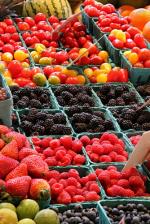What Is Fructose Malabsorption?
Fruit is a usually healthy choice, but for those with fructose malabsorption, the wrong kind of fruit (or too much of it) can cause painful consequences. Nutrition Diva explains how to deal with fructose malabsorption.
Monica Reinagel, MS, LD/N, CNS
Listen
What Is Fructose Malabsorption?

However, there is a limit to how much fructose your body can process at one time. Could fructose be a hidden cause of your digestive distress? Today, I have some tips on how to diagnose and deal with fructose malabsorption.>
A friend of mine once sent me a huge crate of plump, ripe cherries from his family’s orchard in Washington state as a gift. They were so good—and it was such a rare treat—that I couldn’t stop eating them, and I ended up with a righteous stomachache. Most likely, the discomfort I experienced was caused by over-loading my system with too much fructose, one of the naturally-occurring sugars in fruit.
See also: Ask the Diva: Is Fructose Bad For Your Liver?
For those with fructose malabsorption, even a single serving of fresh fruit can cause problems.
Most of us can only absorb between 25-50 grams of fructose at a sitting—a bit more or less, depending on what other sugars are present in the meal. Unless you’re being immoderate (as I was that night), you’re unlikely to consume that much at a meal. Some people, however, have a much lower threshold. For those with fructose malabsorption, even small amounts of fructose, such as the amount in a single serving of fresh fruit, can cause problems.
Any fructose that isn’t absorbed remains in the large intestine, where the bacteria that normally reside there will start to digest it. This produces carbon dioxide gas, which can lead to bloating, belching, or flatulence. Fructose also pulls water into the intestines through the process of osmosis, which can cause cramping and diarrhea.
How to Tell if You Have Fructose Malabsorption

Fructose malabsorption can be definitively diagnosed by your doctor with a hydrogen breath test. However, you can do a simple experiment: Follow the dietary prescription recommended for people with fructose malabsorption. If you have a noticeable improvement in gas, bloating, and other symptoms, it may be that you have some degree of fructose malabsorption.
3 Tips for Dealing with Fructose Malabsorption
Tip #1: Avoid Foods with High Percentage of Fructose
As the name suggests, fruit is a major dietary source of fructose. But it’s also found in small amounts in vegetables and grains. Concentrated sweeteners, such as table sugar, honey, maple syrup, corn syrup, and agave nectar also contain varying amounts of fructose.
You’ll almost never find fructose all by itself, however. It’s almost always accompanied by or bonded to other sugars, such as glucose. This works out well because glucose enables the absorption of fructose. The first important rule for those with fructose malabsorption is to avoid foods and sweeteners that contain more fructose than they do glucose. Below, you’ll find a chart of common culprits. For processed foods, you’ll need to do some label reading – which is a good idea anyway!
#High fructose corn syrup can contain anywhere from 42% to 55% fructose. Although the 42% variety would not be a problem for those with fructose malabsorption, the 55% would. Unfortunately, there’s no way to tell the percentage of fructose in corn syrup from the way it’s listed on the label. To be on the safe side, avoid all foods made with high fructose corn syrup.
Tip #2: Keep total fructose intake moderate

Here’s the good news: If you are following my recommendation to keep your intake of all added sugars to less than 5-10% of your calories, then you are already doing this!
See also: How to Reduce Your Added Sugar Intake
I also recommend limiting your fruit intake to 2-3 servings a day and not more than one serving at any one time. Be particularly careful with dried fruit: a serving is just ¼ cup or a very small handful.
Tip #3: Fructose May Not Be the Only Problem
If following these recommendations eliminates your symptoms, keep up the good work and enjoy the benefits. If you get partial but not total relief, you may have other triggers besides fructose. My best advice would be to try the FODMAP diet, which eliminates other foods that commonly cause digestive distress.
Keep in Touch
Do you have a nutrition question or a suggestion for a future show topic? Send it to nutrition@quickanddirtytips.comcreate new email or post it on the Nutrition Diva Facebook page. Be sure to subscribe to my free weekly newsletter for more nutrition tips, recipes, and answers to your nutrition questions.
References
Fructose malabsorption and symptoms of Irritable Bowel Syndrome: guidelines for effective dietary management. J Am Diet Assoc. 2006 Oct;106(10):1631-9. Link to abstract.

